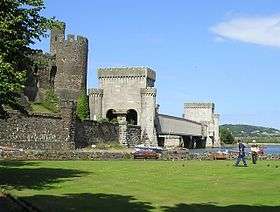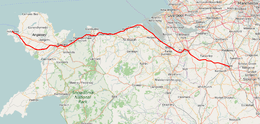North Wales Coast Line
| North Wales Coast Line | |||
|---|---|---|---|
 | |||
| Overview | |||
| Type | Heavy Rail | ||
| System | National Rail | ||
| Locale |
Anglesey Gwynedd Conwy Denbighshire Flintshire Cheshire | ||
| Termini |
Crewe Holyhead | ||
| Stations | 18 | ||
| Operation | |||
| Opened | 1850 | ||
| Owner | Network Rail | ||
| Operator(s) |
Arriva Trains Wales Virgin Trains | ||
| Character | Coastal | ||
| Rolling stock |
Class 67 Class 150 "Sprinter" Class 153 "Super Sprinter" Class 158 "Express Sprinter" Class 175 "Coradia" Class 221 "SuperVoyagers" | ||
| Technical | |||
| Line length | 84.38 miles (135.80 km) | ||
| Number of tracks | Double track mostly except on Britannia Bridge between Bangor and Llanfair PG where it is single track | ||
| Track gauge | 4 ft 8 1⁄2 in (1,435 mm) standard gauge | ||
| Operating speed | 90 mph (140 km/h) maximum | ||
| |||
The North Wales Coast Line (Welsh: Rheilffordd Arfordir Gogledd Cymru), also known as the North Wales Main Line,[1] is the railway line from Crewe to Holyhead. Virgin Trains consider their services along it to be a spur of the West Coast Main Line.
In April 2006, Network Rail organised its maintenance and train control operations into "26 Routes". The main line through Crewe forms part of Route 18 (The West Coast Main Line). The North Wales Coast Line from Crewe (North Junction) to Chester and North Wales has been designated Route 22 (North Wales and Borders) and this includes the line to Chester from Acton Grange Junction, south of Warrington. The line from Shrewsbury to Chester via Wrexham is Route 14 (South and Central Wales and Borders) (until Saltney Junction).
The line is not currently electrified, so Virgin Trains, the current operator of the InterCity West Coast franchise, currently uses its diesel Super Voyagers, which they have done since December 2007, on routes to Holyhead. There are no official plans to electrify the line, but both the Welsh government and former Chancellor George Osborne have indicated that there is a strong case for electrification in the future.
The line contains several notable engineering structures, namely Conwy railway bridge across the River Conwy, and Britannia Bridge across the Menai Strait.
History
The first section from Crewe to Chester was built by the Chester and Crewe Railway and absorbed by the Grand Junction Railway shortly before opening in 1840. The remainder was built between 1844 and 1850 by the Chester and Holyhead Railway Company as the route of the Irish Mail services to Dublin. The line was later incorporated in the London and North Western Railway. Between Chester and Saltney Junction, the line was, from the start, used by trains of the Shrewsbury and Chester Railway later to be incorporated in the Great Western Railway.
So important was the line in the 19th and early 20th centuries to passenger, mail and freight traffic between Britain and Ireland that the world's first experimental and operational water troughs were installed at Mochdre between Colwyn Bay and Llandudno Junction. Their purpose was to enable steam engines (especially on the Irish Mail) to collect water without stopping. Later, considerable stretches of line between Chester and Colwyn Bay were quadrupled to increase line capacity but these sections have now been reduced to two tracks.
Main calling points
The main towns served by the route are listed below:
- Crewe
- Chester
- Line diverges to serve Wrexham, Shrewsbury and Cardiff (via the Shrewsbury to Chester Line - Route 14)
- Wirral Line diverges to serve Birkenhead and Liverpool - Route 21 (Merseyrail)
- Shotton
- The Borderlands Line (part of Route 22) from Wrexham to Bidston crosses at Shotton with interchange facilities.
- Flint
- Prestatyn
- Rhyl
- Abergele
- Colwyn Bay
- Llandudno Junction
- Lines diverge to serve Blaenau Ffestiniog (via the Conwy Valley Line) and Llandudno
- Conwy
- Penmaenmawr
- Llanfairfechan
- Bangor
- Llanfairpwll
- Line diverges to Amlwch (Anglesey Central Railway, disused)
- Bodorgan
- Ty Croes
- Rhosneigr
- Valley
- Freight from Wylfa nuclear power station is loaded at a depot in Valley
- Holyhead
Services
Principal through passenger services are London Euston to Holyhead, Bangor, Chester and Wrexham General operated by Virgin Trains (West Coast) and Crewe to Holyhead, Cardiff to Holyhead and Manchester to Llandudno currently operated by Arriva Trains Wales (who replaced First North Western). A revised timetable has operated since December 2005 incorporating a new service to and from Cardiff Central every two hours. The line still provides the UK railway part of the through passenger service to Dublin using fast car ferries from Holyhead to Dublin Port or Dún Laoghaire. From Dún Laoghaire railway station the DART trains connect with Dublin Connolly.
Future
The Welsh Government would like the line to be electrified, especially if Crewe becomes a rail hub due to HS2 in 2026.[2] Chancellor George Osborne said in July 2015 that there was a "really strong case" for electrification of the line.[3] The Electrification Task Force said that the Chester to Crewe line was a Tier 2 priority for being electrified in the CP6 period (2019-2024).[4] A £50 million signalling upgrade programme is currently being carried out between Shotton and Colwyn Bay, which will see modular colour lights supervised from the South Wales Rail Operating Centre in Cardiff replace the manual signal boxes and mixture of semaphore and older colour lights currently in use, in March 2018.[5]
References
- ↑ "Route Utilisation Strategy - Wales" (PDF). Network Rail. 2011. Retrieved 7 February 2012.
- ↑ Williamson, David (21 March 2014). "HS2 report has pushed electrification of North Wales rail line forward, Welsh Secretary claims". Wales Online. Retrieved 27 November 2015.
- ↑ "'Strong case' for north Wales rail electrification". BBC News. 17 July 2015. Retrieved 27 November 2015.
- ↑ "Electrification Task Force Final Report Revealed". Rail North. 5 March 2015. Retrieved 27 November 2015.
- ↑ £50m North Wales Railway Upgrade Project underway Network Rail Media Centre; Retrieved 4 August 2017
Further reading
Route map: Google
- Allen, David (18 June – 1 July 1997). "Sun, sea, sand...and semaphores". RAIL. No. 307. EMAP Apex Publications. pp. 40–45. ISSN 0953-4563. OCLC 49953699.
